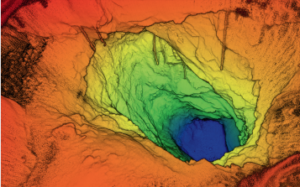Robotics in the future of mining – by Qantas SPIRIT
Special Report: Mining, the new frontier
Autonomous drones, intelligent software, scientific advances, new-age analytics, and world-leading education – the future of the resources sector is here, writes Jane Nicholls in the Qantas SPIRIT magazine.
Featuring Fred Pauling, Group Leader for the Robotics and Autonomous Systems Group, below is an extract from the article around the role of Robotics in the future of mining operations and its vital role in safety and increased productivity.
The full article also looks at software, higher education, science, and data analytics.
What’s next in… robotics
Automation has already made mining safer and more predictable, with autonomous trains, trucks and drilling rigs being directed by city-based operations centres thousands of kilometres away.
“One of the challenges for the future mine will be doing that more efficiently,” says Fred Pauling, leader of the Robotics and Autonomous Systems Group, part of the CSIRO’s data innovation network, Data61. Pauling envisages automated haulage underground – not by the massive trucks that rumble across mine sites today but by “multiple smaller vehicles hauling less ore but doing it more quickly so that the overall system is more robust”.
While not specifically focused on resources, Data61’s Sixth Wave Alliance, announced in May, is vital to the sector. Foundation partners include the federal government’s Department of Industry, Innovation and Science; National Energy Resources Australia; and oil and gas giant Woodside.
The mission is to advance robotics technologies. “Australia has highly relevant research capabilities in robotics,” says Pauling. He points to the International Conference on Robotics and Automation, held in Brisbane in May, as a “big signal” of this – it was the first time the global event has been held in the Southern Hemisphere.

We’re already a world leader in aerial autonomy, says Pauling, citing the Data61-developed Hovermap, a module that turns a drone into an autonomous craft capable of flying solo and navigating underground, mapping the terrain in 3D using lasers.
Last September, Hovermap completed a world-first autonomous flight beyond the line of sight inside Jundee, a Northern Star Resources goldmine in Western Australia.
“A mine surveyor can sit the Hovermap on the ground, point it vaguely in the direction of the stope [the excavated interior where minerals are being extracted], press the button and it will fly into and around the stope, gathering all the data it needs to map it, then fly back and land exactly where it took off from – all in a matter of minutes,” says Pauling.
The autonomous drone mission is an achievement for Data61 and the results are revolutionary. “We showed the data to mine geotechnicians and they were blown away by the detail,” says Pauling. “It’s providing much richer information in a safer and more timely way.” Hovermap is expected to be launched this year by Emesent, fulfilling the Data61 mission to develop and commercialise Australian technology.
To learn more about our research and mining technologies, contact us.
